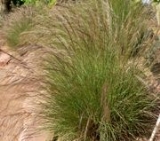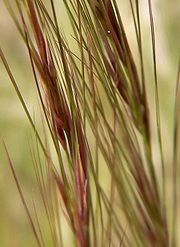
Three-awn
Encyclopedia


Grass
Grasses, or more technically graminoids, are monocotyledonous, usually herbaceous plants with narrow leaves growing from the base. They include the "true grasses", of the Poaceae family, as well as the sedges and the rushes . The true grasses include cereals, bamboo and the grasses of lawns ...
genus
Genus
In biology, a genus is a low-level taxonomic rank used in the biological classification of living and fossil organisms, which is an example of definition by genus and differentia...
Aristida, distinguished by having three awns (bristles) on each lemma
Lemma (botany)
Lemma is a phytomorphological term used in botany referring to a part of the spikelet of grasses . It is the lowermost of two chaff-like bracts enclosing the grass floret. It often bears a long bristle called an awn, and may be similar in form to the glumes - chaffy bracts at the base of each...
of each floret. The genus includes about 300 species
Species
In biology, a species is one of the basic units of biological classification and a taxonomic rank. A species is often defined as a group of organisms capable of interbreeding and producing fertile offspring. While in many cases this definition is adequate, more precise or differing measures are...
, found worldwide, often in arid warm regions. This genus is among those colloquially called "wiregrass
Wiregrass
The name wiregrass may refer to:* Poaceae grasses** Aristida , especially A. stricta , A. junciformis and A...
es", "speargrasses" or "needlegrass
Needlegrass
The term needlegrass may refer to any of several genera of grasses, including:*Achnatherum*Aristida *Nassella*Stipa...
es".
Aristida stems are ascending to erect, with both basal and cauline leaves. The leaves may be flat or inrolled, and the basal leaves may be tufted. The inflorescence
Inflorescence
An inflorescence is a group or cluster of flowers arranged on a stem that is composed of a main branch or a complicated arrangement of branches. Strictly, it is the part of the shoot of seed plants where flowers are formed and which is accordingly modified...
s may be either panicle
Panicle
A panicle is a compound raceme, a loose, much-branched indeterminate inflorescence with pedicellate flowers attached along the secondary branches; in other words, a branched cluster of flowers in which the branches are racemes....
-like or raceme
Raceme
A raceme is a type of inflorescence that is unbranched and indeterminate and bears pedicellate flowers — flowers having short floral stalks called pedicels — along the axis. In botany, axis means a shoot, in this case one bearing the flowers. In a raceme, the oldest flowers are borne...
-like, with spiky branches. The glumes of a spikelet are narrow lanceolate, usually without any awns, while the lemmas are hard, three-veined, and have the three awns near the tip. The awns may be quite long; in A. purpurea var. longiseta
Aristida purpurea
Aristida purpurea is a species of grass native to North America which is known by the common name purple three-awn. This grass is fairly widespread and can be found across the western two thirds of the United States, much of southern Canada and parts of northern Mexico...
they may be up to 10 cm.
They are characteristic of semiarid grassland
Grassland
Grasslands are areas where the vegetation is dominated by grasses and other herbaceous plants . However, sedge and rush families can also be found. Grasslands occur naturally on all continents except Antarctica...
. The Wiregrass Region
Wiregrass Region
The Wiregrass Region or Wiregrass Country is an area of the Southern United States encompassing parts of southern Georgia, southeastern Alabama, and the Florida Panhandle...
of North America
North America
North America is a continent wholly within the Northern Hemisphere and almost wholly within the Western Hemisphere. It is also considered a northern subcontinent of the Americas...
is named for A. stricta
Aristida stricta
Aristida stricta is a warm-season grass, native to North America, that dominates understory vegetation in sandhills and flatwoods coastal plain ecosystems of the Southeastern United States...
. Other locales where this genus is an important component of the ecosystem
Ecosystem
An ecosystem is a biological environment consisting of all the organisms living in a particular area, as well as all the nonliving , physical components of the environment with which the organisms interact, such as air, soil, water and sunlight....
include the Carolina Bay
Carolina Bay
Carolina bays are elliptical depressions concentrated along the Atlantic seaboard within coastal Delaware, Maryland, New Jersey, North Carolina, South Carolina, Virginia, Georgia, and northcentral Florida...
s, the sandhills
Sandhills (Carolina)
The Sandhills is a region in the interior of the U.S. states of North Carolina and South Carolina. It is a strip of ancient beach dunes which generally divides the Piedmont from the coastal plain, and is the evidence of a former coastline when the ocean level was higher, or the land lower. The...
of the Carolinas
The Carolinas
The Carolinas is a term used in the United States to refer collectively to the states of North and South Carolina. Together, the two states + have a population of 13,942,126. "Carolina" would be the fifth most populous state behind California, Texas, New York, and Florida...
and elsewhere
Sandhill
A sandhill is a type of ecological community or xeric wildfire-maintained ecosystem. It is not the same as a sand dune. It features very short fire return intervals, one to five years. Without fire, sandhills undergo ecological succession and become more oak dominated.Entisols are the typical...
, Mulga scrub in Australia
Australia
Australia , officially the Commonwealth of Australia, is a country in the Southern Hemisphere comprising the mainland of the Australian continent, the island of Tasmania, and numerous smaller islands in the Indian and Pacific Oceans. It is the world's sixth-largest country by total area...
, and the xeric grasslands around Lake Turkana
Lake Turkana
Lake Turkana , formerly known as Lake Rudolf, is a lake in the Great Rift Valley in Kenya, with its far northern end crossing into Ethiopia. It is the world's largest permanent desert lake and the world's largest alkaline lake...
in Africa
Africa
Africa is the world's second largest and second most populous continent, after Asia. At about 30.2 million km² including adjacent islands, it covers 6% of the Earth's total surface area and 20.4% of the total land area...
.
On the other hand, a local increase of the amount of "wiregrass" – which is not well liked by livestock
Livestock
Livestock refers to one or more domesticated animals raised in an agricultural setting to produce commodities such as food, fiber and labor. The term "livestock" as used in this article does not include poultry or farmed fish; however the inclusion of these, especially poultry, within the meaning...
– is a good indicator of overgrazing
Overgrazing
Overgrazing occurs when plants are exposed to intensive grazing for extended periods of time, or without sufficient recovery periods. It can be caused by either livestock in poorly managed agricultural applications, or by overpopulations of native or non-native wild animals.Overgrazing reduces the...
.
Selected species
- Aristida adscensionisAristida adscensionisAristida adscensionis is a species of grass known by the common name Sixweeks threeawn. It is native to the Americas but it is distributed nearly worldwide. It grows easily in disturbed and waste areas and has potential to become a weed....
L. - Aristida anaclastaAristida anaclastaAristida anaclasta is a species of grass in the Poaceae family.It is found only in Yemen.-Source:* Miller, A. 2004. . Downloaded on 20 July 2007....
- Aristida basiramea – Fork-tipped Three-awn, Forked Three-awn
- Aristida behrianaAristida behrianaAristida behriana is a native Australian species of grass, commonly known as Bunch Wire Grass or Brush Wire Grass. It is a bright-green, perennial plant forming short, tufted tussocks up to high. Its seeds have three long, radiating awns leading to an occasional name of three-awn grass. The...
F.Muell. - Aristida beyrichiana
- Aristida burkei – bohlanya-ba-pere (Sesotho: "horse-madness grass")
- Aristida californicaAristida californicaAristida californica is a species of grass known by the common names California threeawn and Mojave threeawn. It is native to the Mojave Deserts and Sonoran of northern Mexico and California and Arizona.-Description:...
- Aristida calycina R.Br.
- Aristida chaseaeAristida chaseaeAristida chaseae is a rare species of grass known by the common name Chase's threeawn. It is endemic to Puerto Rico, where it is known from two locations in the Cabo Rojo National Wildlife Refuge and the Sierra Bermeja. It is a federally listed endangered species of the United States...
- Aristida contorta F.Muell.
- Aristida dichotoma Michx. – Shinner's Three-awn, "poverty grassPoverty grassPoverty grass may refer to:*Any of several grasses that grow in poor or sandy soil, for example:** Aristida dichotoma, Shinner's Three-awn** Eremochloa bimaculata** Sporobolus vaginaeflorus , Sheathed Dropseed...
" - Aristida divaricataAristida divaricataAristida divaricata is a species of grass known by the common name poverty threeawn. It is native to the Americas from the central United States to Guatemala. It is a perennial grass forming clumps of unbranched stems up to 70 centimeters tall. Leaves are mostly basal and roll along the edges...
- Aristida granitica
- Aristida guayllabambensisAristida guayllabambensisAristida guayllabambensis is a species of grass in the Poaceae family.It is found only in Ecuador.-References:* Laegaard, S. & Pitman, N. 2004. . Downloaded on 20 July 2007....
- Aristida hygrometrica R.Br.
- Aristida junciformis
- Aristida longespica – Slim-spiked Three-awn
- Aristida longespica var. geniculata – Red Three-awn
- Aristida longespica var. longespica
- Aristida mutabilis
- Aristida oliganthaAristida oliganthaAristida oligantha is a species of grass known by the common names prairie threeawn and oldfield threeawn.It is native to the United States and southern Canada, and it is known from northern Mexico. It is a grass of many types of habitat, and it grows easily in dry areas with sandy or gravelly soils...
Michx. – Prairie Three-awn - Aristida pallens Cav.
- Aristida portoricensisAristida portoricensisAristida portoricensis is a rare species of grass known by the common name pelos del diablo . It is endemic to Puerto Rico, where it is known from two locations, one in a residential area of Mayagüez and one in the Sierra Bermeja. Two other known sites have been extirpated by development of the...
– Pelos del diablo - Aristida pungensAristida pungensAristida pungens is a member of the family Poaceae.-Uses:The grass is known in Arabic as Drinn. It is a tall perennial plant with deep roots and long leaves. Extremely drought resistant, drinn grows in areas with as little as 70 mm of rainfall per year...
– Drinn - Aristida purpurascens Poiret – Arrowfeather Three-awn
- Aristida purpureaAristida purpureaAristida purpurea is a species of grass native to North America which is known by the common name purple three-awn. This grass is fairly widespread and can be found across the western two thirds of the United States, much of southern Canada and parts of northern Mexico...
– Purple Three-awn- Aristida purpurea var. longiseta
- Aristida ramosa R.Br.
- Aristida refracta
- Aristida spiciformis
- Aristida strictaAristida strictaAristida stricta is a warm-season grass, native to North America, that dominates understory vegetation in sandhills and flatwoods coastal plain ecosystems of the Southeastern United States...
– Pineland Three-awn, "wiregrassWiregrassThe name wiregrass may refer to:* Poaceae grasses** Aristida , especially A. stricta , A. junciformis and A...
" - Aristida suringarii
- Aristida swartziana
- Aristida tenuifolia
- Aristida vagans
- Aristida vaginata
See also
- New Mexico State University Botanical GardenNew Mexico State University Botanical GardenThe New Mexico State University Botanical Garden is a group of botanical gardens, herbaria, and agricultural facilities associated with New Mexico State University in Las Cruces, New Mexico....
has a large collection of local Aristida species - Puccinia aristidaePuccinia aristidaePuccinia aristidae is a plant pathogen that causes rust on Aristida, spinach and primula.- External links :* *...
, a plant pathogenic urediniomycete fungus first described from three-awn grass - List of Poaceae genera

